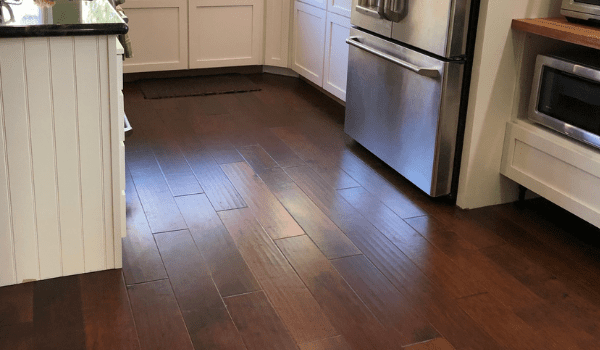Is this you? You walk into a room in your home, and you realize something isn’t quite right with your floors. You see scratches, chips or stains that were barely noticeable before. But now they are glaring back at you from every angle.
The question is, can these problems be fixed? If so, what is the fix? And can you afford it?
This article will help you find those answers.
Can Your Floors be Fixed? And can You Afford it?
The good news is that most flooring can be repaired or refinished. Stained carpet can be cut away and a new piece from your existing remnants can be seemed in. Cracked or deeply pitted tile can be removed and replaced as well (as long as you have spare tile).
Much like carpet, laminate and Luxury Vinyl (LVP) will need to have the damaged or warn sections removed – along with surrounding sections. Once that is done, new planks or sheets (from your existing remnants) will be inserted in their place. And Presto! New again.
“It’s always good to order a little extra flooring, just in case you need to replace a section. This will ensure that your repaired section matches your existing floor perfectly.”
But what about Hardwood?
Hardwood offers several different options. Many of which enable you to keep your floor AND have a new floor too (If only the same could be said about cake…. Ha!).
All kidding aside, hardwood can be sanded and refinished multiple times during its life, and it can even be recolored. That means many kinds of wear and damage can be whisked away to reveal a fresh, new floor. This is true for BOTH solid hardwood and engineered hardwood.
The one limiting factor will be the thickness of the surface (aka wear) layer . This layer MUST be at least 2mm thick to give the hardwood specialist room to work with.
One easy way to check your wear layer is to lift your floor-based HVAC vent cover. That will give you a look at an end cut of your hardwood and of course the floors layers. If you have solid hardwood, simply measure the thickness of the plank from top to bottom. If you have engineered wood, you’ll typically see three different layers set up in a crisscross fashion. Only the top-most layer is your wear layer so be sure to measure only this one.
If you do not have a floor register, its best to call a hardwood specialist to check the wear layer for you.
If your wood floors are showing scratches and pits or peeling – refinishing is an easy and affordable way to make them new again. Your flooring specialist will sand away as little as 1 to 1.5 millimeters (1/25 to 1/19 of an inch) of wood, and then apply a new finish to preserve and protect your “new” floors.
For more serious issues such as deep ruts and hollows, warping or slanting, you can often repair and replace damaged sections, without replacing the whole floor. If you are renovating, especially if you are moving cabinets or interior walls, replacement is usually your best bet.
Repair may consist of removing damaged boards or sanding deeper into the hardwood (up to an 1/8 of an inch) to rid it of grooves, and then applying a new finish. In some cases, stain may need to be applied to even out color. For severe damage such as unstable, loose boards, or a subfloor that has been eaten away by mold or termites, complete replacement is usually best option. But don’t make that decision until you have talked to a professional.
When to Call a Hardwood Expert
Some indicators that something unseemly is happening beneath the surface of your floor are:
- Soft Spots: When walking across certain sections of your floor, you may feel an area that is soft or gives way underfoot . This can be an indication that the subfloor has deteriorated, due to mold or termites.
- Small Holes: Tiny holes in your floor, coupled with mounds of sawdust around the perimeter of those holes is an indication that termites have been chewing away at your floor or subfloor.
- Instability: Does your floor creak or wiggle when you walk on it? Does it have a noticeable slant? Are there gaps between planks? These are all signs of instability in your subfloor or in the floor itself.
If you notice any of the above issues, call a flooring expert right away. The faster you act, the more of your floor you may be able to preserve.
Learn more about hardwood repair and refinishing. And for an in-depth look at hardwood, get our essential guide to hardwood floors.





